|
Flowspeed Oil Pump Modification For 5-Main MGB Engines.
Just because you have a new oil pump does not ensure it will be up to the task of your modified engine. Spirited driving (like Autocross or performance street use) can put high demands on oil pump flow and capacity. The following article displays the oil pump modifications we make when building engines for street and competiton use.
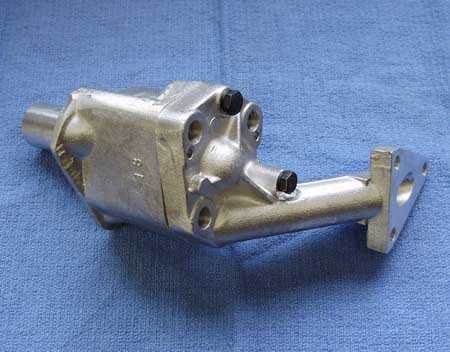 This is a new, County brand oil pump, available from all major parts suppliers. We will start our modification process by removing the two bolts seen in this photo, socket size is 10mm. This is a new, County brand oil pump, available from all major parts suppliers. We will start our modification process by removing the two bolts seen in this photo, socket size is 10mm.
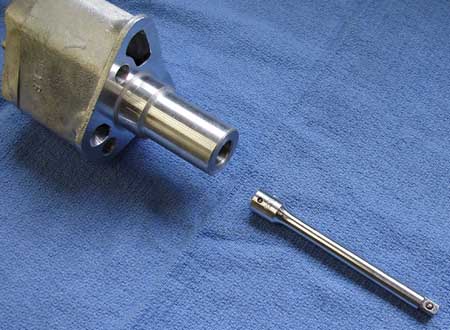 After removing the two bolts shown previously, we place a 1/4-drive socket extension into the pump drive bore. After removing the two bolts shown previously, we place a 1/4-drive socket extension into the pump drive bore.
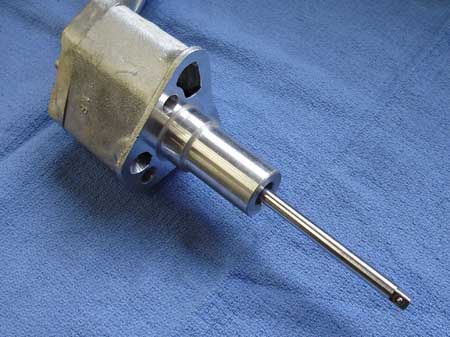 The socket extension is used as a drift to drive against the pump rotor and knock the cover plate loose. We use a small, soft faced mallet, as a light tap is all it takes. The socket extension is used as a drift to drive against the pump rotor and knock the cover plate loose. We use a small, soft faced mallet, as a light tap is all it takes.
 Disassembling the pump leaves you with the parts seen here. Disassembling the pump leaves you with the parts seen here.
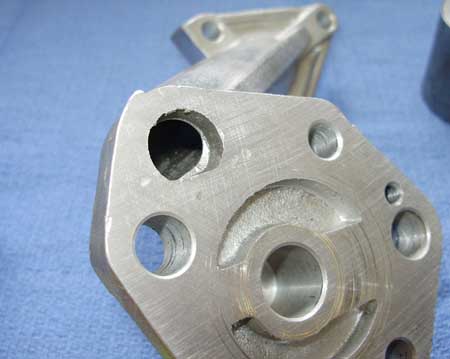 Starting with the cover plate, we see sharp edges present where the incoming oil makes the turn into the pump body. Also note that the hole is not round (but should be). Starting with the cover plate, we see sharp edges present where the incoming oil makes the turn into the pump body. Also note that the hole is not round (but should be).
 By spending time with a small carbide burr on a die grinder, we open the hole to the proper round shape and radius the sharp edges. This work eases flow of the oil from the pickup, into the pump body itself. By spending time with a small carbide burr on a die grinder, we open the hole to the proper round shape and radius the sharp edges. This work eases flow of the oil from the pickup, into the pump body itself.
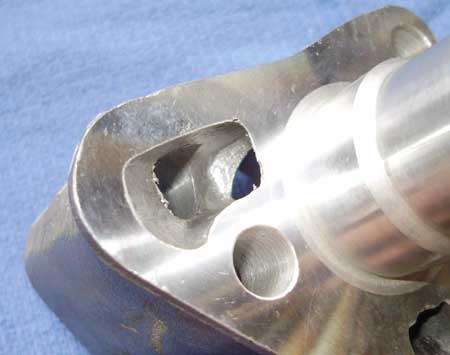 From the cover plate, the oil will travel up the pump body until it meets this transfer junction. The sharp edges presented to the oil flow in this view are obvious. From the cover plate, the oil will travel up the pump body until it meets this transfer junction. The sharp edges presented to the oil flow in this view are obvious.
 Our goal is to smooth the transition of the oil from the pump body, to the rotor cavity by physically smoothing this junction area. A comparison with the previous photo shows a dramatic improvement. Our goal is to smooth the transition of the oil from the pump body, to the rotor cavity by physically smoothing this junction area. A comparison with the previous photo shows a dramatic improvement.
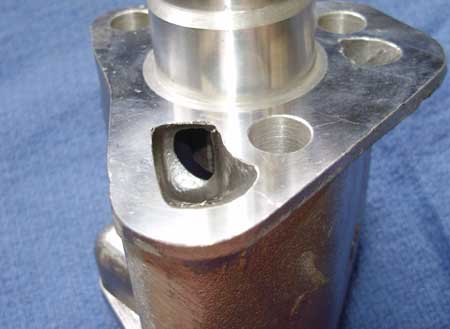 Looking at the same area from another angle shows how restrictive the stock castings can be. All the pumps we've taken apart have exhibited varying levels of obstruction, similar to this one. Looking at the same area from another angle shows how restrictive the stock castings can be. All the pumps we've taken apart have exhibited varying levels of obstruction, similar to this one.
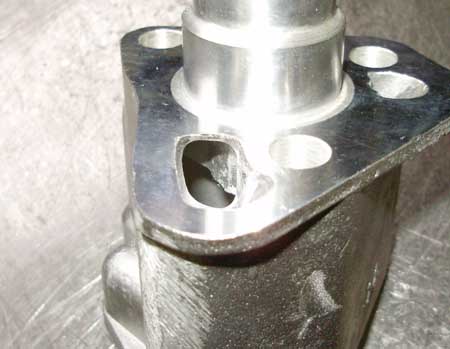 Comparing this photo to the previous one will give an idea of the dramatic increase in port opening size. Comparing this photo to the previous one will give an idea of the dramatic increase in port opening size.
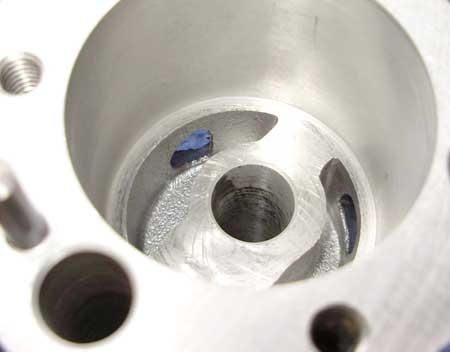 Looking at the same port from the rotor cavity side, again shows how restrictive a stock pump can be. Looking at the same port from the rotor cavity side, again shows how restrictive a stock pump can be.
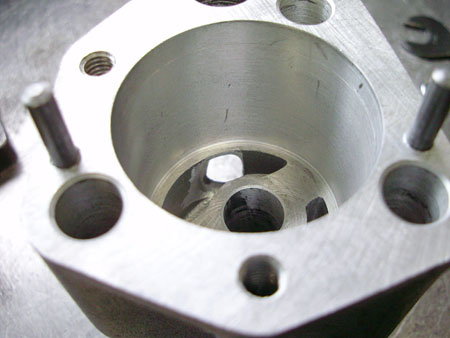 Comparing the last photo to this one, shows a vast increase in port opening area. Comparing the last photo to this one, shows a vast increase in port opening area.
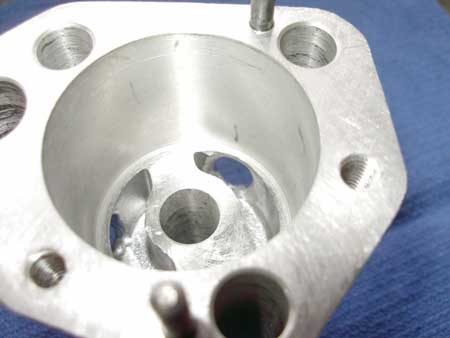 Just as with the pump inlet port, we also modify the pump outlet port for equal flow capability. Both the entry and exit of this passage are smoothed and enlarged. Just as with the pump inlet port, we also modify the pump outlet port for equal flow capability. Both the entry and exit of this passage are smoothed and enlarged.
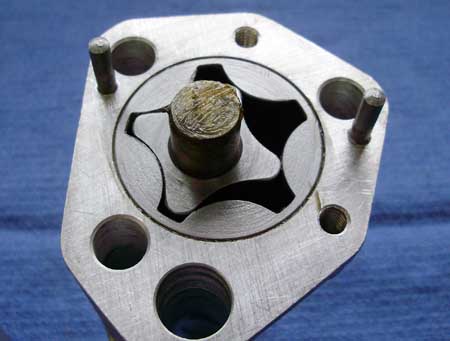 After cleaning all pump parts spotless and making the clearance checks outlined in the factory manual, all parts are coated with assembly lube and reinstalled. After cleaning all pump parts spotless and making the clearance checks outlined in the factory manual, all parts are coated with assembly lube and reinstalled.
 During reassembly, we like to use a small drop of thread locking compound on each of the two retaining bolts to ensure they do not loosen in service. During reassembly, we like to use a small drop of thread locking compound on each of the two retaining bolts to ensure they do not loosen in service.
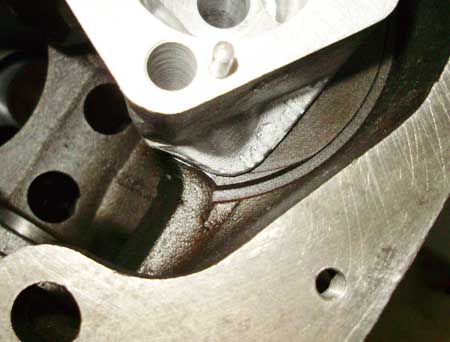 One critical check to make, is clearance of the oil pump with the block. As can be seen in this photo, a sharp ridge left from the block machining process is interfering with the oil pump. While the gasket thickness may take up some of the difference, removing excess pump material with a file is a better idea. One critical check to make, is clearance of the oil pump with the block. As can be seen in this photo, a sharp ridge left from the block machining process is interfering with the oil pump. While the gasket thickness may take up some of the difference, removing excess pump material with a file is a better idea.
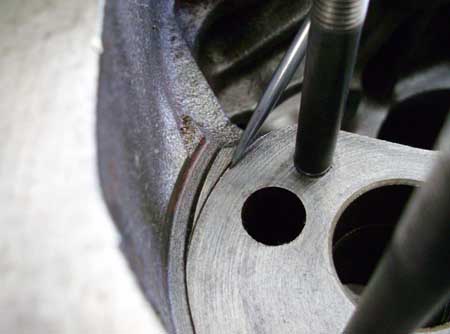 A closeup of the ridge in the block shows where interference occurs. A closeup of the ridge in the block shows where interference occurs.
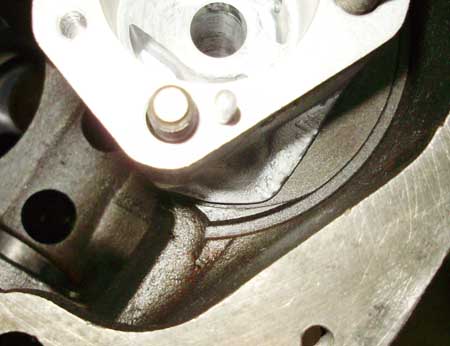 After modifying the edge of the pump body with a file, plenty of clearance is obtained for a guaranteed seal once the pump is torqued in place. After modifying the edge of the pump body with a file, plenty of clearance is obtained for a guaranteed seal once the pump is torqued in place.
Home | Cylinder Heads | Articles
For Sale | Contact
Unless otherwise noted, all material is:
©2010 Sean Brown
All rights reserved.
| |


















